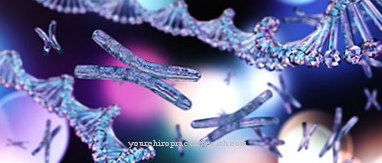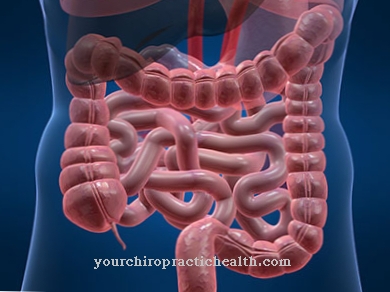An electrical excitation of the heart muscles, which has its origin outside the normal excitation center (sinus node), is called extrasystole. The origin of excitation of the supraventricular extrasystole lies “above” the division of the HIS bundle and thus mostly within the atria. If the origin is in the myocardium of the atria, there is a corresponding phase shift of the normal rhythm, but not if the supraventricular extrasystole originates from the AV node.
What is a supraventricular extrasystole?

© Koroleva - stock.adobe.com
The normal heart rhythm is determined by the sinus node in the right atrium in the confluence area of the superior vena cava and runs through the atria to the AV node (atrioventricular node) in the septum of the two atria close to the ventricles. The AV node forwards the contraction signal with a slight time delay via the HIS bundle, the Tawara thighs and the Purkinje fibers to the ventricular muscles.
An extrasystole is characterized by the fact that the source of excitation lies outside the sinus node and provokes an - usually harmless - additional heartbeat. Supraventricular extrasystoles (SVES) assume so-called ectopic excitation centers in the atria or in the area of the AV node above the division of the HIS bundle into the two Tawara legs.
The ectopic excitation centers of the supraventricular extrasystoles are therefore always outside the chambers. If the excitation center is formed by muscle cells in the atria, the electrical discharge “overwrites” the sinus phase, so that there is a corresponding shift in the normal rhythm. If the ectopic excitation is in the area of the AV node, the sinus rhythm is not affected, so that there is no phase shift. The additional systole then occurs
causes
Supraventricular extrasystoles are usually completely harmless and are not indicative of any heart disease. SVES also occur in completely healthy people and are classified as normal. The cause of SVES shows a wide range and ranges from heavy coffee and nicotine consumption or alcohol consumption to excessive sympathetic activity to fatigue and electrolyte disorders.
A lack of potassium is particularly noticeable. Frequently occurring SVES can also be caused by coronary heart disease, myocarditis or an overactive thyroid (hyperthyroidism). If one of the diseases that are likely to be causative can be diagnosed, therapy should target the treatment of the causative disease.
Symptoms, ailments & signs
The symptoms that accompany supraventricular extrasystoles range from imperceptible to anxiety. Symptoms such as sweating or nervous restlessness are rare. SVES are usually much less noticeable than ventricular extrasystoles, the excitation centers of which are located in one of the chambers.
Occasionally, extrasystoles can be felt as dropouts in an expected regular systole or there is a very rapid succession of several heartbeats in succession before the normal rhythm resumes. In some people, such symptoms can lead to mental reactions because they develop feelings of fear.
This can result in nausea, dizziness and frequent urination. If the symptoms of supraventricular extrasystoles accumulate, it is advisable to clarify the causes, because frequent SVES can indicate a possible underlying disease of the heart or the thyroid gland.
Diagnosis & course of disease
An important diagnostic tool for detecting SVES is the EKG (electrocardiogram), which can provide information about the type of extrasystole. However, with only occasional extrasystole, it is left to chance that such an event takes place during the recording of the ECG, is recorded and is therefore accessible for analysis.
In the many cases in which there is no extrasystole during the recording of the ECG, a so-called long-term ECG can help. It is a mobile EKG recording device that is worn on the body for a period of 24 hours and records continuously. The data are saved on a data carrier and can be evaluated with the help of special software.
The computer-aided evaluation reveals above all cardiac arrhythmias and the number and quality of any extrasystoles. If a certain heart disease is suspected, ultrasound examinations and, for example, an examination of the coronary arteries (angiography) can provide further information.
Since supraventricular extrasystoles cannot be viewed as an independent disease, the further development of the irregularities of the heartbeat depends on the course of the underlying disease. If there is no underlying disease, no treatment for SVES is usually necessary.
Complications
Supraventricular extrasystole can cause a number of complications. Occasionally, those affected suffer from nervous restlessness and even anxiety. Symptoms such as sweating or skin irritation rarely occur. A serious complication are the cardiac arrhythmias that sometimes occur, which may subside after a few seconds, but can trigger panic attacks and anxiety in some people.
In the further course of the extrasystole, nausea, dizziness and a frequent need to urinate can also occur - symptoms that significantly reduce the quality of life and increase the risk of accidents in everyday life. Further complications generally stem from the causal disease. For example, if there is a heart disease, life-threatening cardiac arrhythmias or even cardiac arrest or heart failure can occur.
If left untreated, thyroid disease can unbalance a wide variety of body processes and lead to serious complications. Whether undesirable side effects occur during treatment depends on the cause of the supraventricular extrasystole. Diseases of the internal organs are usually treated with drugs or surgery - both of which are associated with risks and side effects. Some patients also have an allergic reaction to the substances and materials used.
When should you go to the doctor?
The person concerned needs a medical consultation as soon as symptoms such as sweating, inner restlessness, irritability or general malaise occur. If conditions of fear or panic suddenly develop, this is considered unusual and should be discussed with a doctor. Disorders of the heart, changes in blood pressure and a rapid decline in physical performance must be examined and treated. Sudden and unmediated racing of the heart, which then turns into normal heart activity, is a warning signal of the organism. The person concerned should see a doctor to clarify the cause of these unusual contractions of the heart.
Dizziness, unsteady gait, vomiting or nausea are further signs of an existing health condition. A doctor's visit is necessary as soon as the symptoms persist, recur or increase. If the impairment leads to emotional or mental complaints, a doctor must also be informed of the changes. Changes in behavior, feelings of illness, and aggressive behavior should be investigated more closely.
Characteristic of this disease is a sudden appearance of the symptoms, which is accompanied by an abrupt disappearance of the irregularities. Even though symptoms are resolved after a short period of time, a doctor should be consulted, as heart failure can occur in severe cases.
Treatment & Therapy
Usually, supraventricular extrasystoles do not need to be treated. Therapy is only indicated if there is an underlying disease that requires treatment. If, for example, more than 10,000 extrasystoles are counted in a long-term ECG over a period of 24 hours, there is usually an underlying disease.
If no heart disease and no disease of the thyroid gland can be determined, a review of the lifestyle with regard to coffee and alcohol consumption and with regard to the duration and frequency of strong stress phases is recommended. Light physical exercise and relaxation exercises can reduce the frequency of extrasystoles that cannot be assigned to a specific disease. In all other cases, therapy is aimed at treating the underlying disease. After they have healed, the number of extrasystoles reduces by itself.
prevention
There are no specific, preventive measures that could prevent the excessive occurrence of supraventricular extrasystoles. Basically, a "natural" way of life is recommended, in which phases with increased stress potential alternate with phases of relative recovery.
This is the only way to guarantee a balance between our unconscious sympathetic and parasympathetic nervous systems. A natural and healthy lifestyle naturally includes a minimum amount of exercise and a diet that also includes foods that are left natural.
Aftercare
The supraventricular extrasystole is usually a harmless finding that does not require any follow-up care. However, if the cause of the cardiac arrhythmia is known and a palpable stumbling of the heart is a psychological burden for the person concerned, aftercare options are available. These serve on the one hand to minimize the risk of the occurrence of supraventricular extrasystole and on the other hand to psychologically cope with the symptom.
Stress is often the trigger for the supraventricular extrasystoles. Those affected can often do a lot to reduce it. In addition to reducing private and professional obligations as much as possible, relaxation exercises are a good option. These include, for example, progressive muscle relaxation according to Jacobsen or fantasy journeys, for both of which there are instructions on CD.
Endurance training can also have a positive effect on the supraventricular extrasystole in terms of the frequency of its occurrence. Jogging, walking and cycling, for example, are ideal. It is also important to drink enough water. Yoga can be helpful for body, mind and soul through a mixture of asanas (physical exercises), pranayama (breathing exercises), meditation and deep relaxation, also with regard to the supraventricular extrasystoles.
Those who suffer mentally from palpitations are often in good hands in a self-help group. Contact with like-minded people offers valuable exchange and can reduce fears so that the person concerned does not develop a massive cardiac neurosis from the supraventricular extrasystole.
You can do that yourself
The supraventricular extrasystole is a common and harmless finding. Once it has been clarified by a general practitioner, internist or cardiologist, it usually no longer needs to be checked or treated. However, there are cases in which the supraventricular extrasystole is very annoying for the person affected, sometimes even frightening him. There are a few ways that self-help can reduce extrasystoles.
Exercise is often helpful. The supraventricular extrasystoles often arise when adrenaline is formed in the body due to stress and excitement. Sport, especially dosed endurance training, is able to lower the adrenaline level in the body. This is also particularly helpful when perceived supraventricular extrasystoles disturb the patient's sleep. Relaxation methods such as progressive muscle relaxation or yoga can also help to positively influence the supraventricular extrasystole or at least relieve the fear of harmless heart stumbling.
If the fear gets out of hand, it is advisable to go to a psychologist or an alternative practitioner. Here behavior therapy or naturopathic methods can be used to learn how to deal better with palpitations from a psychological point of view. The serenity that can be learned in this context is ideal for a stress-free organization of everyday life and work, which in turn can have a positive effect on the reactions of the heart.


.jpg)


.jpg)





















